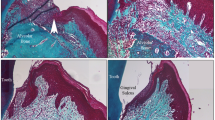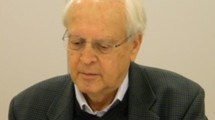Summary
Wound contraction in soft tissue has been attributed to the activity of contractile fibroblasts containing actin microfilaments. Immunochemical staining at the electron microscopic level was used to demonstrate the presence of such cells in healing wounds from skin and oral mucosa. Biopsies of granulation tissue from 10 and 16 day old excision wounds in beagle palate mucoperiosteum and skin were fixed and 10 μm sections were treated with antiactin serum, peroxidaseanti peroxidase (PAP) and then incubated to reveal the localization of actin. Controls were prepared using non-immune serum or preabsorbed immune serum. Thin sections examined with the electron microscope revealed the presence of PAP particles associated with microfilament bundles beneath the plasma membrane and in processes of fibroblasts. Reaction was also associated with micropinocytotic vesicles at the cell surface. More reactive cells were seen in 16 day than in 10 day old wounds and there were greater numbers of these cells in skin than in oral mucoperiosteum. The results indicate that actin containing cells with the ultrastructural characteristics of contractile fibroblasts (myofibroblasts) are present in the granulation tissue of healing skin and oral mucosal wounds. Such cells may be responsible for the wound contraction observed clinically in the healing palatal mucoperiosteum.
Similar content being viewed by others
References
Abercrombie M, Flint MH, James DW (1954) Collagen formation and wound contraction during repair of small excised wounds in the skin of rat. J Embryol Exp Morphol 2:264–274
Bendayan M (1981) Ultrastructural localization of actin in insulin-containing granules. Biol Cell 41:157–160
Bendayan M (1983) Ultrastructural localization of actin in muscle, epithelial and secretory cells by applying the protein A-gold immunocytochemical technique. Histochem J 15:39–58
Caselitz J, Loning T (1981) Specific demonstration of actin and keratin filaments in pleomorphic adenomas be means of immunoelectron microscopy. Virchows Arch (Pathol Anat) 393:153–158
Dabelsteen E, Kremenak CR (1978) Demonstration of actin in the fibroblasts of healing palatal wounds. Plast Reconstr Surg 62:429–435
Dunphy JE (1974) Wound healing. Medcom Pres, New York
Forer A (1982) Actin localization within cells by electron microscopy. In: Wilson L (ed) Methods in cell biology. Vol 25: The cytoskeleton, Part B. Academic Press, New York, pp 131–142
Gabbiani G, Majno G, Ryan GB (1973) The fibroblast as a contractile cell: the myo-fibroblast. In: Kulanem E, Pillarainen J (eds) Biology of fibroblast. Academic Press, New York, pp 139–154
Gabbiani G, Ryan GB, Majno G (1971) Presence of modified fibroblasts in granulation tissue and their possible role in wound contraction. Experientia 27:549–550
Ghoneim S, Squier CA, Satter SE, Kremenak CR (1979) Quantitation of contractile fibroblasts in healing palatal wounds. J Dent Res 58:abst 1132
Goldman RD (1975) The use of heavy meromyosin binding as an ultrastructural cytochemical method for localizing and determining the possible functions of actin-like microfilaments in non-muscle cells. J Histochem Cytochem 23:529–542
Hirschel BJ, Baggiani G, Ryan GB, Majno G (1971) Fibroblasts of granulation tissue: Immunofluorescent staining with anti-smooth muscle serum. Soc Exp Biol Med 139:466–469
Ishikawa HR, Bischoff R, Holtzer H (1969) Formation of arrowhead complexes with heavy meromyosin in a variety of cell types. J Cell Biol 43:312–328
Kremenak CR, Searls JC (1971) Experimental manipulation of midfacial growth: a synthesis of five years of research at the Iowa Maxillofacial Growth Laboratory. J Dent Res 50:1488–1491
Majno G, Gabbiani G, Hirschel BJ, Ryan GB, Statkov PR (1971) Contraction of granulation tissue in vitro: similarity to smooth muscle. Science 173:548–549
McGrath MH, Hundahl SA (1982) The spatial and temporal quantification of myofibroblasts. Plast Reconst Surg 69:975–983
Montandon D, D'Andiran G, Gabbiani G (1977) The mechanism of wound contraction and epithelialization, clinical and experimental studies. Clin Plast Surg 4:325–346
Moriarty GC, Moriarty CM, Sternberger LA (1973) Ultrastructural immunocytochemistry with unlabelled antibodies and the peroxidase-antiperoxidase complex. A technique more sensitive than radio-immunoassay. J Histochem Cytochem 21:825–833
Olin W, Morris J, Geil J, Pratt S, Kremenak C (1974) Contraction of mucoperiosteal wounds after palate surgery in beagle pups. J Dent Res 53:abst 378
Osung OA, Tok BK, Gray A, Sotelo J, Yildiz A, Diggle T, Holborow EJ (1980) Immunoperoxidase EM localization of cytoplasmic actin in cultured fibroblasts. J Immunol Methods 34:303–313
Peacock EE, Van Winkle W (1976) Wound repair, 2nd ed. WB Saunders, Philadelphia, pp 54–79
Ryan GB, Cliff WJ, Gabbiani G, Irle C, Montandon D, Statkov PR, Majno G (1974) Myofibroblasts in human granulation tissue. Human Pathol 5:55–67
Rudolph R (1979) Location of the force of wound contraction. Surg Gynecol Obstet 148:547–551
Sandoz D, Goimon P, Korsenti E, Sauran ME (1982) Immunocytochemical localization of tubulin, actin and myosin in axonemes of ciliated cells from quail oviduct. Proc Natl Acad Sci USA 79:3198–3202
Spooner BS, Holladay CR, Bright GR (1982) Immunofluorescence comparisons of anti-actin specificity. Eur J Cell Biol 28:115–121
Squier CA, Kremenak CR (1980) Myofibroblasts in healing palatal wounds of the beagle dog. J Anat 130:585–594
Sternberger LA (1979) Immunocytochemistry, 2nd ed. John Wiley & Sons, New York
Tiggemann R, Plattner H, Rasched I, Bauerle P, Wachter E (1981) Quantitative data on peroxidatic markers for electron microscopy with a note on actin identification in Paramecium cells. J Histochem Cytochem 29:1387–1396
Wakely J, Badley RA (1982) Organization of actin filaments in early chick embryo ectoderm: an ultrastructural and immunocytochemical study. J Embryol Exp Morphol 69:169–182
Webster RE, Henderson D, Osborn M, Weber K (1978) Three dimensional electron microscopical visualization of the cytoskeleton of animal cells: immunoferritin identification of actin-and tubulin — containing structures. Proc Natl Acad Sci USA 75:5511–5515
Willingham MC, Yamada SS, Davies PJA, Rutherford AV, Gallo MG, Pastan I (1981) The intracellular localization of actin in cultured fibroblasts by electron microscopic immunocytochemistry. J Histochem Cytochem 29:17–37
Author information
Authors and Affiliations
Rights and permissions
About this article
Cite this article
Squier, C.A., Leranth, C.S., Ghoneim, S. et al. Electron microscopic immunochemical localization of actin in fibroblasts in healing skin and palate wounds of beagle dog. Histochemistry 78, 513–522 (1983). https://doi.org/10.1007/BF00496203
Accepted:
Issue Date:
DOI: https://doi.org/10.1007/BF00496203




